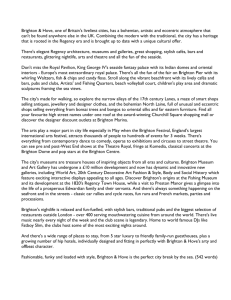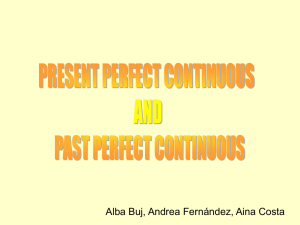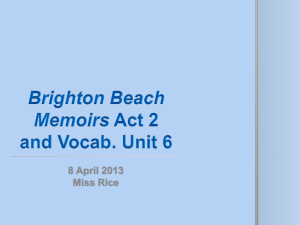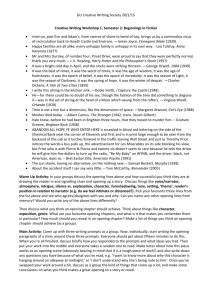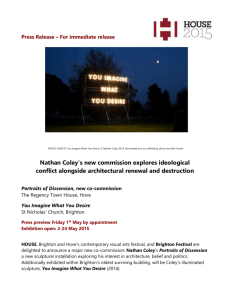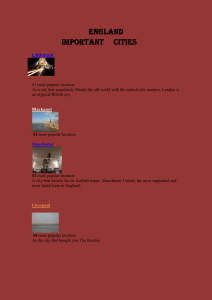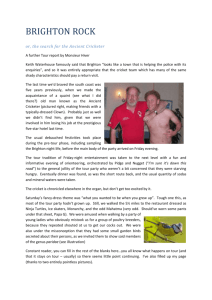CV - Photography Open Salon
advertisement
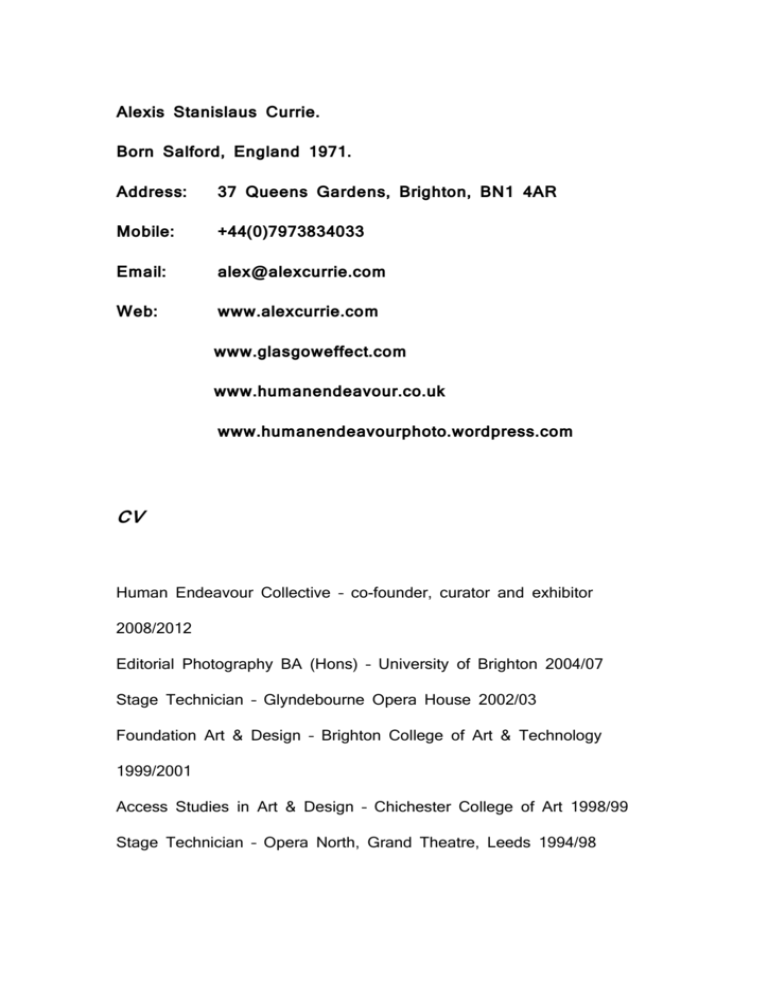
Alexis Stanislaus Currie. Born Salford, England 1971. Address: 37 Queens Gardens, Brighton, BN1 4AR Mobile: +44(0)7973834033 Email: alex@alexcurrie.com Web: www.alexcurrie.com www.glasgoweffect.com www.humanendeavour.co.uk www.humanendeavourphoto.wordpress.com CV Human Endeavour Collective – co-founder, curator and exhibitor 2008/2012 Editorial Photography BA (Hons) – University of Brighton 2004/07 Stage Technician – Glyndebourne Opera House 2002/03 Foundation Art & Design – Brighton College of Art & Technology 1999/2001 Access Studies in Art & Design – Chichester College of Art 1998/99 Stage Technician – Opera North, Grand Theatre, Leeds 1994/98 EXHIBITIONS Degeneration – B Book Show, Hackney, London, March 2012 www.photobookshow.co.uk Degeneration – A Book Show, Workflow Studios, Brighton, December 2011 www.photobookshow.co.uk Degeneration – Hereford Photography Festival, UK, October/November 2011 Degeneration – Zaragoza Photography Festival, Spain, September/October 2011 Degeneration – Collectives Encounter/Format International Photography Festival, Derby, March/April 2011 Salon Photo Prize – Matt Roberts Arts, Vyner Street, London, February 2011 Degeneration – Brighton Biennial Fringe, Bellis Gallery, Brighton, Oct/Nov 2010 Une Exposition de Paysage Contemporain - La Mediateque de l'Horte et Lavalette, Villebois Lavalette, Charente, France, August 2010 END – Human Endeavour, Crane Kalman Gallery, Brighton, May 2010 OOPs (Objects Of Perception) – Fiveways AOH, Brighton Festival Fringe, May 2009 Human Endeavour – BPF, Bellis Gallery, Brighton, October/November 2008 A Series of Investigations – (In)Difference, Hackney, London, July/August 2008 Five at Fiveways – Artist’s Open House, Brighton Festival Fringe, May 2008 Solo Show – Terence Conran & Partners, Brighton, March/April 2008 (In)Difference – Group Exhibition, La Viande Gallery, London, November 2007 Degree Show – Brighton University Gallery, June 2007 Triptych – Maholy-Nagy University of Art & Design, Budapest, April 2006 Triptych – Brighton University Gallery, February 2006 New England – Artist’s Open House, Brighton Festival Fringe, May 2005 STUDIO Phoenix Arts Brighton, 3N7, 10–14 Waterloo Place, Brighton, BN2 9NB www.phoenixarts.org AWARDS/PUBLICATIONS Awarded Arts Council funding for the curation and production of works for the group show ‘Human Endeavour’, featuring Murray Ballard, Simon Carruthers, Richard Chivers and Alex Currie, as part of the Brighton Photo Fringe, 2008. Foto 8 Festival Report, 21st January 2009. http://www.foto8.com/home/content/view/767/436/ Source Photographic Review, Issue 57, Winter 2009. Review of ‘Human Endeavour’ exhibition by Eugenie Shinkle. Awarded Arts Council for the curation and production of works for the collaborative project ‘Degeneration’, on behalf of the ‘Human Endeavour’ collective, exhibited as part of the Brighton Photo Fringe 2010. ‘Human Endeavour’ book ‘Degeneration’ published by Ubyu in December 2010 to accompany the exhibition and continuing tour in 2011/12. ‘Degeneration’ published in British Journal of Photography magazine in June 2011. ‘Degeneration’ published as story of the week on Foto8 website, September 2011. http://www.foto8.com/new/online/photo-stories/1464-degeneration www.humanendeavour.co.uk noun the state or process of being or becoming degenerate; decline or deterioration: overgrazing has caused serious degeneration of grassland. • Medicine deterioration and loss of function. ‘Degeneration’ is the third show exhibited and curated by the photographic collective ‘Human Endeavour’, and the second show to be supported by the Arts Council of England. The collective is an evolving platform incorporating different photographers, with the commonality of interest of human intervention and activity in the 21st century. Simon Carruthers, Richard Chivers and Alex Currie instigated the formation of the collective, and have been constant members throughout, with previous participants including Murray Ballard, Oliver Perrott and Ben Westoby. Unlike previous exhibitions, which have been curated around a central theme incorporating existing bodies of work into one exhibition, ‘Degeneration’ is a collaborative project, produced and curated from its inception as a whole body of work, incorporating the metropolitan conurbations of Glasgow, Edinburgh, Newcastle, Gateshead, Leeds, Liverpool, Salford, Sheffield, Derby, Birmingham, Cardiff, Bristol, London and Portsmouth. To do this Simon Carruthers, Richard Chivers, Alex Currie and Oliver Perrott have been researching the relevant areas and the sociological implications involved since the autumn of 2009. With ‘Degeneration’ being a research led project, the objective is to take a critical look at the state of housing and regeneration in the 21st century, and the implications and complex nuances this may have on some of the poorest in society, reliant upon social housing. After several decades of neglect, consecutive governments have overseen the gradual demise and disappearance of social housing, due to ‘Right To Buy’ and a lack of new housing stock built, arguably fuelling the necessity to own rather than let that has instigated the artificial inflation of the housing market. This opens up many questions as to why this was allowed to happen, has fuelled the rise in homelessness and poverty and left the majority of people living in social housing trapped in so called ‘sink estates’. DEGENERATION Text by Richard Healey In the post-war era Britain's population was faced with massive housing shortages. The existing housing stock was often disgracefully inadequate for even the most basic of needs. Modernist architecture with its close links to left wing ideology reflected a progressive solution to the practical and social issues of the time. At its height in the 50’s Social Housing was unquestionably a central devastation pillar of of the Britain's Second regeneration World War. following Modern, the and affordable, it represented an advancement in society; where the working classes were for the first time given the opportunity to live in a decent home. These projects and buildings were often striking exercises, bold and futuristic in their character ambition. and breathtaking in the scale of their Of course not everything proposed and executed by the town planners was to be warmly received. The high level philosophy and design of Corbusier was all too frequently brought crashing down to earth by the constraints of both economy and ability. Despite the misgivings, the new house or flat on the estate offered to millions the promise of a new beginning; a chance of escape from the almost medieval squalor endured by working class families through generations since time immemorial. But this wasn't only about a specific part of the demographic. Social Housing was intended for all, to encourage the integration of different echelons of society. As late at the mid 70’s you would find a wide range of people living on these estates. Our home was in a tower block in Sheffield's Norfolk Park. My father was a skilled tradesmen, our neighbour a teacher: the commonality shared by the occupants of these developments was that of employment. These places were on the whole very positive places to live in, vibrant and open with a strong sense of community. However by as quickly as 1979 the political landscape in our country had changed forever. Our leaders decided that talk of society was no longer valid, the interests of the individual reigned supreme and through the Right To Buy scheme we were encouraged to take part in the dismantling of this great social project. Those who could, took advantage of the schemes. The theory was straightforward enough. If you give people the opportunity to own something themselves then they will take greater care of it than the state ever could. Their emotional connection to their homes will be stronger. Individuals will be empowered, less docile more entrepreneurial, all will benefit. Within a decade most of the new property owners had sold up and moved on. Who was left behind? And what did it mean to be there? A council tenancy now carried with it a sense of failure and increasingly blame. Within the upwardly mobile paradigm it's your own fault if you are poor, isn't it? 80's Beyond the physical our psychological relationship towards these estates and buildings was quickly and profoundly altered. Far from being symbols of hope and egalitarianism, estates became places to avoid. The notoriety increased exponentially through the 80's and 90's. Names such as Moss Side or Red Road taking on almost mythic proportions, becoming as much feared and despised as the very slums and tenements which they replaced. The rampant excesses of the housing market in the late 1990’s, which lead to an Englishman's home becoming not only his castle but his retirement fund, all but finished the job started almost thirty years earlier. The unabashed pursuit of wealth and self-interest seeming to prove that there really was no such thing as society after all. Housing Estates today have come to be associated with high levels of social stigma; they are seen as places of social exclusion. Homes to the forgotten under-classes. They provide the stage backdrop to our broken society neuroses. As compelling and titillating as any of Hogarth's scenes. But in the midst of all the media hyperbole and theorising what are these places? Even today are they not people's homes? Places where children play and belong, where treasured childhood memories are formed however repellant this may seem to middle class observers? What do we see when we look at these images of neglect and decay? How strikingly the physical neglect and abandonment of these homes and proud ambitions seems to reflect the disintegration and malaise of our society as a whole and perhaps even ourselves as individuals.

